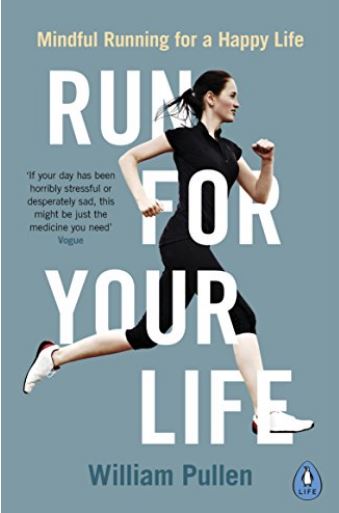Do you ever feel calm and relaxed after a run? Psychotherapist and mindfulness expert, William Pullen explains how ‘mindfulness running’ can be an effective form of therapy
I decided it was time I became a runner. I came across ‘Run Regents Park’ for Macmillan Cancer Support. Then it came to me, I’ll train for the next 5 weeks and run a 5K race, 5 weeks to 5K – preferably without stopping. As I’m a writer for Healthista, I can regale you with the journey every week.
For week four of my ‘Running For Beginners Diary’ I wanted to start getting more out of my runs than just fitness or weight loss. Take walking my dogs as an example. I may be walking my dogs, helping my fitness and adding to my weight loss, but I’m also clearing my head and processing all my thoughts and feelings.

Walking my dogs gives me time to think and relax. I’m able to think and go over anything that has bothered me or that I am anxious about.
Busy city workers rarely find time for themselves. When advised to try morning yoga or meditation before bed they laugh and say ‘as if I have time for that’. I totally get it – by the time you do get home the last thing you want to do is start watching a YouTube video on ‘how to meditate’.
So what if we could incorporate mindfulness into something we already do during the day, like walking or running? This is where William Pullen’s book Run For Your Life, Mindful Running for a Happy Life becomes my new must-have read.
This idea of ‘mindfulness running’ can work perfectly for busy city workers who can try to incorporate mindfulness into their morning, lunchtime or evening run.
According to Pullen, mixing mindfulness with running helps us to tune out from our busy and hectic schedules, and be able to reduce stress, channel positive and unwinding thoughts through the act of running or walking.
So how we can merge mindfulness with running? Let’s find out…
What is Dynamic Running Therapy?
Have you ever been for a long walk or run in the fresh air and suddenly had a moment of clarity where all things simply fall into place? Ever been for a walk with friends and come up with some of the best ideas or solutions to your problems? William Pullen says that this feeling of clarity is the basis of Dynamic Running Therapy (DRT) otherwise known as mindfulness running. ‘Movement shifts perspective and, in so doing provides clarity,’ says Pullen.
Pullen describes Dynamic Running Therapy (DRT) as ‘a powerful and engaging step-by-step therapeutic method for confronting difficult feelings and circumstances in your life through movement, movement is medicine’. Pullen continues, ‘movement is healing – a medicine not just for the body but also for the mind and soul’.
A 2018 study involving 158 college students revealed that mindful movement can help lower your anxiety and stress levels.
Movement is healing – a medicine not just for the body but also for the mind and soul.
Simply put DRT is discussing and working through issues and stresses with yourself whilst running or moving, you do this by focusing on specific questions whilst you run (I will explain more about this later).
Mindfulness is a therapeutic technique that many use to improve mental health. Mindfulness incorporates a focus on becoming aware of your breathing, thoughts, feeling and the sensations around you.
The key concept of ‘mindfulness’ is to focus on the immediate present, what’s around you, how you are feeling right now and how you can make peace with your thoughts. DRT shares with mindfulness a belief that by acknowledging our feelings and thoughts we can make peace with them.
Pullen explains that DRT can be adapted to whatever level of fitness you have as long as you are somehow challenging yourself physically or getting your blood flowing a little faster than it is used to.
DRT can be particularly useful for those who feel stuck or worn down. It can help those who often find themselves in a low mood, or are depressed, anxious or stressed.
Research shows how effective walking and running can be in easing the symptoms of conditions such as anxiety and stress. Combining this with how empowering it can feel to take control of your own situation and you will have the perfect recipe to create change.
If you are feeling the need to deal with anger issues, relationship problems, anxiety or stress then mindfulness running is what you need to do asap.
But how does DRT work?
Pullen explains in his book that DRT involves three simple steps. Grounding, Moving and Journalling.
Grounding is noticing how you feel before your run with the grounding process that you complete before every run (see below).
Moving is your actual run where you will tackle your issues through going over specific questions during your run.
Then finally journalling is when you return from your run and write everything down that you can remember feeling or thinking about during your mindful run.
Step one: Grounding
This is a process of mindfulness where you need to check in with yourself and your environment. First a do a Body Scan. Find a comfortable spot, at home before you leave or on a park bench as long as you are able to find stillness. Uncross legs and arms and take some deep breaths.
Notice how your body feels against the chair, bench or floor, notice points of contact and any accompanying sensations. With more deep breaths, release your shoulders. Start directing your attention to different points of your body.
Begin at the top of your head, become aware of your body from top to toe, from you facial features to your thighs to your feet and toes. As you work your way down, try to sense each part of your body noticing whatever sensations you come across.
During this process notice how outside thoughts will come and go. Acknowledge them but let them pass by. The goal is to stay in your body and in the moment.
Then do an Environment Scan. Turn your attention away from your body and to the environment that surrounds you. What can you see? What can you smell? What is right in front of you? What can you see in the distance? Are there many different sounds? Is where your sat hard or soft?
Again your goal here is to be present and notice your surroundings without letting other thoughts interfere, if they do, let them pass and focus again on your environment.
Next is an Emotion Scan. Notice how you are feeling emotionally. Not this week or this morning, but how you feel right now. Try not to confuse what you have been feeling with what you are feeling presently. Don’t judge these feelings as pleasant or unpleasant just simply acknowledge that this is how you feel.
Lastly, Priming. This is where you can reflect on what you want to get out of the running session. Choose a question or more from the questions on the subject you want to tackle (see below). As you set off on your run, focus your attention on your chosen question or questions. You could even say out loud the chosen focus of your run, for example ‘what am I stressing out about most?’ This will help determine a sense of purpose before you begin your run.
Step two: choose why you’re running
This step is the actual run. Time to ‘mindfully move’, meaning time to acknowledge without judgement what comes to your mind during your run. If you find yourself drifting off into another topic that is fine and completely normal but try and bring it back to your chosen focus question.
While running notice how you are with yourself and look at yourself with non-judgemental eyes. Pullen says, ‘Be a kind and gentle mentor to yourself. Imagine you are coaching a good friend or a loved one and treat yourself as you would them in your situation’.
Deal with your question as many times as you like or if you have more than one, in any order you like. Below are questions that are specific to the issues mindfulness running is likely to help with.
If you’re running for depression and low mood
Depression or a low mood can strike anyone at any time. Some common signs and symptoms are tiredness, lack of energy, loss of self-confidence, lingering sadness, anxiety, helplessness, loss of appetite, physical aches and pains.
‘If we provide ourselves with the right environment, like a plant we will grow and flourish,’ says Pullen.
According to Pullen, mindfulness running can help you to tackle the feelings of powerlessness and futility that often accompany depression or low mood.
Mindfulness running will help you to become increasingly familiar with your thoughts and feelings providing you with a better understanding.
According to a 2006 Dutch study of 19,288 twins and their families, those who exercised were less anxious, less depressed and more socially outgoing.
The questions below are designed to help you explore, gain awareness and reduce your thoughts and feelings contributing to your low mood or depression. Choose a question or questions that seem to resonate with you:
- What do the words depression and low mood mean to you?
- When did these feelings begin?
- How long have you felt this way, gradual or sudden?
- When is your depression worse or better?
- Do certain situations trigger your depression or low mood?
- If you had to describe this feeling visually, what would it look like?
- If you had to give your low mood or depression a name to make it unique to you, what would it be?
- Does your low mood or depression feel like your fault?
- How would you like others to treat you while you are feeling like this?
- Are you striving towards perfectionism?
- Are some of the thoughts you have been having repetitive?
If you’re running for anxiety
Anxiety is a natural feeling we all experience. But for some this anxious feeling can become excessive and uncontrollable causing your anxiety to become detrimental to you life.
If we learn to acknowledge and tolerate our anxiety as something that is natural then we can start to think of anxiety in a positive way.
We all get nervous and anxious before public speaking or getting somewhere on time for an interview. But if you are feeling anxious for no reason or are finding simple daily chores like going shopping a challenge then your anxiety needs to be addressed.
Common symptoms of anxiety include restlessness, feeling on edge, fatigue, irritability, muscle tension, sleep issues and worrying.
In many cases, unwanted anxiety can be helped. If we learn to acknowledge and tolerate our anxiety as something that is natural then we can start to think of anxiety in a positive way.
The questions below are designed to help you explore and gain awareness of your thoughts and feelings that are contributing to your feelings of anxiety. Choose a question or questions that seem to resonate with you:
- In what ways is the anxiety you feel affecting the quality of your life?
- What words would you use to describe the anxiety you feel?
- Does your anxiety cause you to feel less confident about yourself at times?
- Do you try to avoid certain feelings or facts in your life that might contribute to your anxiety?
- Do you place a lot of demands upon yourself?
- If you had to write a letter to yourself about your anxiety what would you write?
- Is there an area of your life in which you feel unfulfilled?
- Are some of your expectations about life and how it should treat you unrealistic?
- Are you a perfectionist?
- Do you ruminate over things a lot? Do you overthink most situations?
If you’re running for relationships
Relationships are hard and some relationships fail simply because people are different. Where most of our relationship problems begin is with idealisation, the expectation or hope that our partner, sibling, parent, boss or friend will fulfill our fantasies of being truly valued and seen.
Most pain in relationships therefore comes from unfulfilled needs, but where we go wrong is we often leave it too late to express them and by the time we do so, we do it poorly – crying, screaming and shouting.
We convince ourselves that the other person has been deliberately ignoring our clear pleas for change. In time this leads us to shift the blame onto one another which causes tension and friction within the relationship.
But at the heart all the disagreements are an unspoken list of expectations and assumptions. Mindfulness running will help you to look at the assumptions, prejudices and expectations that you experience in your relationships.
At the heart all the disagreements are an unspoken list of expectations and assumptions.
We all know that one of the key solutions to dealing with relationship difficulties is to raise theirs and yours awareness of the problem.
Running with the following questions will help you to reassess the relationships in your life and help you to evaluate your own style of relating. Choose a question or questions that seem to resonate with you:
- Do you have a role you typically play in relationships? The ‘rock’, the ‘pleaser’ or the ‘rebel’.
- What sort of things do you expect from a relationship? Are some of these things unrealistic?
- Do you struggle to end relationships even when you know it’s time?
- Do you find it hard to trust people?
- Do you find it easy to open up to people you are close to or do you conceal your true feelings?
- Do you often feel let down by people?
- Would you say you are judgmental about people, including yourself?
- Is there a certain type of person you are drawn to?
- Do you worry that people wont like you?
- Are you especially sensitive to criticism?
- Is there anger or sadness within you that you are not honest about?
- Is there something you find especially hard to tolerate in others?
- What do you need most from others?
If you’re running for anger
‘Anger: five letters that together make a word with the power to to poison a life,’ says Pullen. A powerful line about a powerful emotion.
We all deal with anger in our own way, some of us scream and shout and others simmer and brood. We all get angry from time to time but sometimes something can show up and bring out the worst in you, revealing anger you didn’t even know you were capable of. This can cause you to feel out of control and for some this is a scary experience.
Common triggers for anger can include vulnerability, stress, unmet needs, past trauma, addiction, disappointment or health problems.
Similar to low mood, exercise has confirmed the link between exercise and a reduction in anger. Addressing anger issues with mindfulness running offers to provide you with grounding techniques that will help you alter your responses in a more constructive way, enabling you to take control of your behavior and express your anger more appropriately.
If you usually brood and simmer until you finally explode, maybe it’s time to think about speaking up about your internal rage sooner rather than later. If you are pugnacious or overly aggressive when angry, maybe you need to learn to rein in your anger.
The questions below will help you to gain awareness and reduce your symptoms of anger. Choose a question or questions that seem to resonate with you:
- Have you experienced someone taking advantage of you or an injustice you can’t get over?
- How often do you feel your anger is a problem?
- What seem to be the major triggers of your anger?
- Where in the body do you feel anger the most?
- Did you have angry, critical or controlling parents?
- Have you experienced a childhood trauma such as divorce, bereavement or violence?
- Do you feel trapped?
- Do you feel powerless?
- Do you feel un-noticed or undervalued?
- Do you feel respected or understood?
- How do others respond to your anger?
Step three: Journalling
So you’ve been for your mindful run with the question or questions that spoke to you and your current issues. Do you feel better? Don’t tell me – tell your journal, write it all down.
This journalling step will allow you to gain profound insight into yourself and your feelings. Putting down on paper what came up during your run will offer some relief from carrying it all in your head and heart and putting it into words.
When you feel overwhelmed it can feel helpful to know you have somewhere else to ‘put’ those feelings – look at your journal as a regular companion or therapist that you can confide in whenever you need to.
The notes you take will serve as a record of your journey. The key is to then revisit these notes and see whether you feel the same and if it still bothers you, if yes then maybe its time to run with that particular issue again. But if you re-read your notes and the issue doesn’t bother you anymore well then mindfulness running did the trick.
My turn to try mindfulness and running
Reading William Pullen’s book Run For Your Life, Mindful Running for a Happy Life, I realised that quite a few of the questions resonated with me. For starters I am way to critical on myself, I’m a perfectionist and I worry about all sorts of stupid things like ringing the dentist – crazy I know. I’ve also been single for over four years, clearly there are some issues I need to think about where relationships are concerned.
I picked three questions to work on in one week, which seemed realistic. I chose:
- What sort of things do you expect from a relationship? Are some of these things unrealistic?
- Do you ruminate over things a lot? Do you overthink most situations?
- Do you place a lot of demands upon yourself?
The main thing I found about mindfulness running was that I really struggled to focus on the question I was addressing. I thought too deeply about someone who had upset me, but then started thinking about something insignificant such as what shall I have for breakfast tomorrow?
Obviously, practice makes perfect and I wont be a mindfulness expert in a week. One thing I did find truly helpful was that thinking about the questions, even going off topic distracted me from thinking about being out of breath or my leggings falling down (one of THE most annoying things about running).
By the end of one run I hadn’t even realised that I had been running for a whole 15 minutes before I checked the time – which for me is astonishing (I normally check my progress every five minutes hoping that it has been at least ten).
So I plan to stick with it. I’ll update you again next week. Watch this mindful space.
Find out how I got on in week one: Running for beginners – 7 steps to getting started, week two: Running for weight loss – 5 tips this Barry’s Bootcamp trainer wants you to know and week three: What to eat if you run.
William Pullen’s book is available t buy on Amazon.
More Healthista Content:
How to relieve stress without drugs – the expert’s guide
60 weight loss tips in 60 days
Should you REALLY feed a cold? The GP’s guide to 9 cold myths
Always tired? These 22 energy hacks will surprise you
Like this article? Sign up to our newsletter to get more articles like this delivered straight to your inbox.




























































